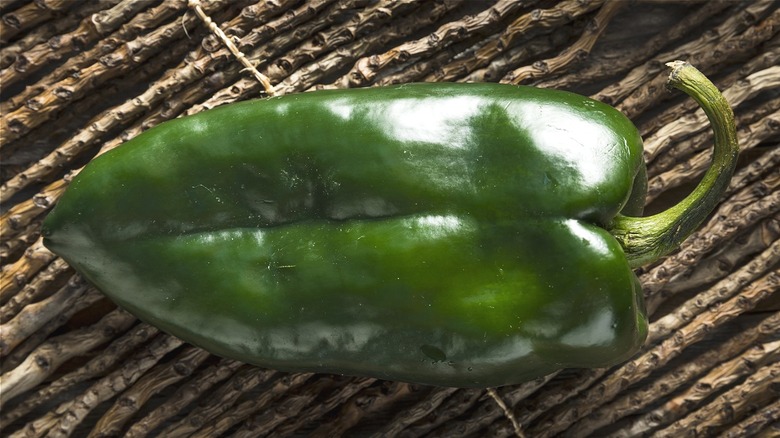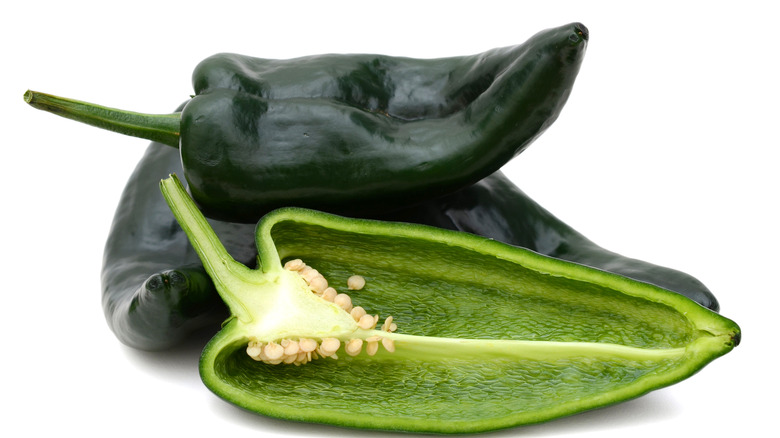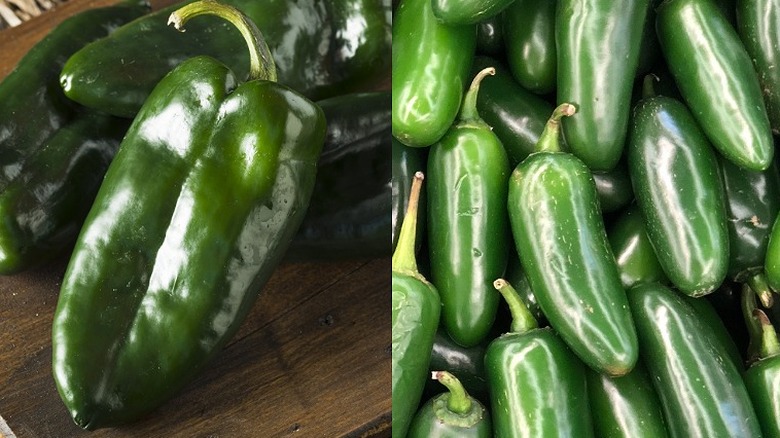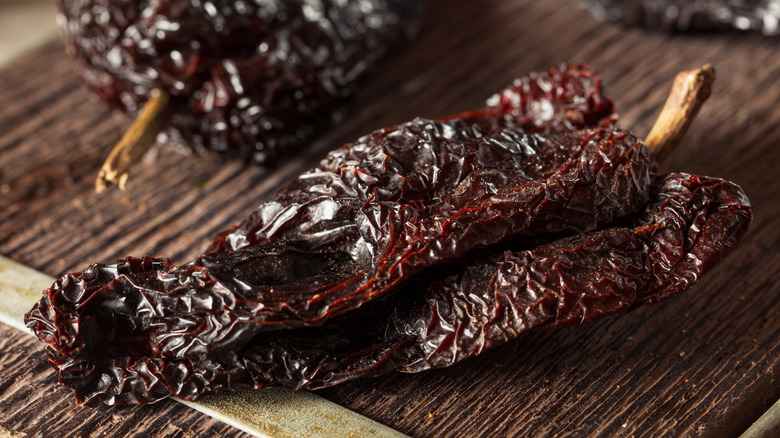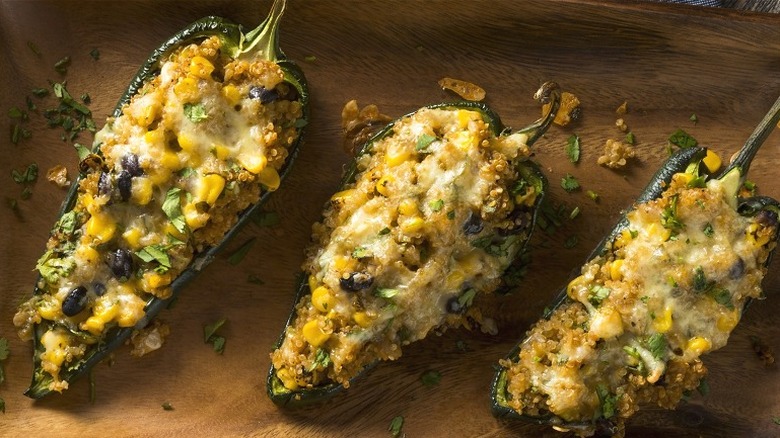What Is A Poblano Pepper And How Spicy Is It?
Reach for a new chili pepper when you head to the produce aisle: the poblano. This beautiful, dark green pepper may be eyed with uncertainty by cooks who haven't yet tried it. Is it hot like a jalapeño? What am I supposed to do with it? It's actually an intriguing type of chili pepper that you can use a ton of ways, fresh or cooked in recipes.
Britannica shares that poblanos belong to the Capsicum annuum family of peppers that includes sweet bell peppers, jalapeños, and cayenne peppers. Poblano peppers originated in Puebla, Mexico, which is a state southeast of Mexico City, and are very popular across that country. The large, elongated peppers have a deep green and glossy surface. As with many peppers, green poblanos are actually underripe; when allowed to ripen the peppers turn a vibrant red.
Poblanos may not get as much splashy press as their painfully spicy cousins like ghost peppers and Carolina reapers, but the size and flavor of poblanos in both fresh and dried forms make them so versatile in cooking. It's a chili pepper worth learning more about.
Are poblano peppers spicy?
This is perhaps the most common question about poblano peppers, which makes sense. The last thing you want is to unknowingly bite into a chili pepper that's way too spicy. With poblanos, you can rest easy.
The spiciness of chili peppers is measured on the Scoville Heat Units (SHU) scale. SHUs can range into the millions for some of the world's hottest peppers, and all the way down to zero for sweet bell peppers. Poblanos peppers range from 1,000 to 2,000 SHUs, which means they're on the mild end of the spectrum. They're slightly milder than slender Anaheim peppers, and far less spicy than serranos, which can have as much as 16,500 SHUs. As for the flavor of poblano peppers, Recipe Marker notes that the taste is like that of a fresh, green bell pepper, but a bit of spiciness and earthiness sets it apart. Fully-ripened, red poblanos will be spicier than green ones.
This low level of heat combined with the size of poblanos mean they're a popular choice for a variety of Latin American and Tex-Mex dishes where they're roasted, stuffed, or blended into sauces.
Poblano peppers vs. jalapeños
Even though poblanos and jalapeños are both green chili peppers, trying to substitute one for another will not give you the same results in your recipe. According to Pepperscale, when you're looking at these peppers at the store, you'll see a size and shape difference. Jalapeños are between 2 and 3 inches long and have a smooth, tapered shape. Poblano peppers are larger, with darker green skin and a surface that's irregular. They bear a resemblance to regular, green bell peppers except that poblanos are more elongated with a pointed tip.
There's quite a difference in spiciness between these two peppers. Whereas poblanos max out at 2,000 Scoville Heat Units (Pepperscale says on average, poblanos will have around 1,250 SHUs), jalapeños range between 2,500 to 8,000 SHUs. That means a jalapeño could be up to eight times hotter than a poblano pepper.
Pepperscale also notes that the peppers taste a little different from each other, saying that the flavor of poblanos is more "earthy," while jalapeños have a fresher and "brighter" taste. Both peppers will bring a chili pepper flavor and spiciness to your recipe, and both are great to stuff with cheesy fillings. However, substituting jalapeños for poblanos means your recipe will have a lot more heat than your guests may be expecting.
Poblanos have other names when dried
When chili peppers are dried, they develop a whole different taste, with flavors that are sweet, earthy, and smoky depending on the way they're dried. PepperScale says that dried peppers have all the heat of fully ripened, fresh chili peppers and may even be hotter. The capsaicin compounds (that make hot peppers hot) become more concentrated as the peppers dry. For many peppers, the dried versions also get different names. One of these is ancho.
According to Chili Pepper Madness, ancho peppers are created by ripening poblano peppers until they're red. The peppers are then completely dried, after which they're a very dark red, wrinkled, and somewhat flattened. Anchos have the same level of heat as poblanos, between 1,000 and 2,000 Scoville Heat Units, but with an "earthier, darker flavor."
The mulato pepper is another dried variety made from poblanos. Chili Pepper Madness says the distinction from anchos is that poblano peppers are ripened past the bright red stage to a very dark, reddish brown color before drying. Once dried, mulato peppers have the same appearance as anchos, though they can be almost black. Because they're made from fully ripened poblanos, mulato peppers are a little hotter, clocking in between 2,500 and 3,000 Scoville units.
Anchos are one of the "holy trinity" of dried chili peppers (with pasillas and guajillos, and sometimes mulatos), used to make traditional Mexican mole sauces.
Where to buy poblano peppers
The variety of chili peppers available in the produce section will vary depending on your region: Stores in the southwest are more likely to keep shelves stocked with chilis as compared with stores in other parts of the country. Look for poblanos in the same area as red and green bell peppers, often side-by-side with baskets of jalapeños. You may find them loose to buy only as many as you need or in shrink-wrapped packages. Choose peppers that have a vibrant color and no soft or shriveled spots.
In the summer, when peppers are in season, check your farmers markets and vegetable stands for locally grown poblano peppers, which will likely taste better than commercially grown produce. If you have a bit of a green thumb, you can try growing your own poblano peppers. According to Bonnie Plants, poblano plants get tall, so they'll need 3 or 4 feet of space in your garden, or a large planter if you want to try container gardening. With plenty of water and sun, you'll have your own poblano pepper harvest in about two and a half months.
If you're looking for dried ancho peppers, check the aisles where spices or Mexican and Hispanic foods are sold. Dried peppers are available from online sources as well.
Here's how to cook with poblanos
Now that you know what they are, it's time to get busy cooking with poblanos! As poblanos are on the large side and aren't too spicy, they're excellent to stuff with a variety of fillings like seasoned meats and beans. Or, stuff them with cheese and deep-fry them to make a classic chiles rellenos. My Latina Table shares that another traditional, more elaborate dish often served during holidays is Chiles en Nogada. Poblano peppers are stuffed with a spicy, sautéed mixture of ground meat and fruit, then smothered in a creamy salsa made with nuts and topped with pomegranate seeds.
You can also enjoy poblanos fresh, like in a pico de gallo style salsa. Another option may be to chop poblanos and stir them into guacamole, and they can also be sprinkled over nachos or casseroles.
Epicurious suggested the peppers could be used to make an enticing chile sauce. The peppers are first charred over a flame, to make them easy to peel and to add a smoky flavor. Then, they're blended with garlic, oil, and other savory ingredients to make a rich, green sauce that's amazing over chicken. Raw or roasted, chopped or puréed, this is a chili pepper worth getting into your shopping basket more often!
